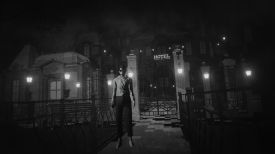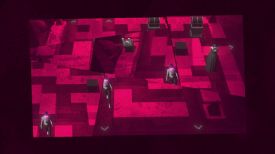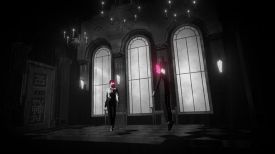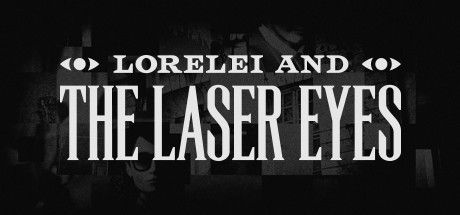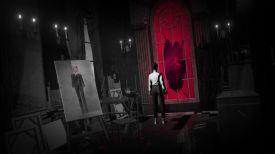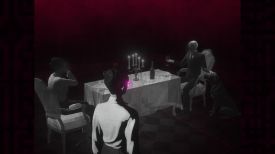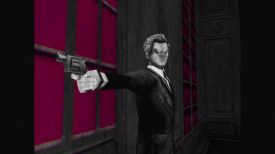|
By flotsam
Lorelei and the Laser Eyes
Simogo/Annapurna Interactive
Despite a dud segment and not
yet getting to the end (it became a bit of a chore), this was overall a
seriously good puzzling time across its impressive length.
You start in the woods, a
stylish young woman with a clutch purse and sunglasses and a car close
by. Rummage a bit and a letter indicates you have come to the Hotel
Letzes Jahr at the behest of Signor Nero to help him “transcend the
limitation of art for humans.” An instruction booklet hints at something
connected, but first things first. A glimpsed sign through the trees
suggests you need to go that way. And so it begins.
Lorelei is a puzzle box writ large, one constructed (largely) of
monochromatic environments demanding to be explored and unpacked. The
who and the what and the why are as puzzling as the myriad of conundrums
that await. Patience and persistence will both be useful virtues.
As will a pen and paper. Whilst
there is an excellent in-game repository of everything you have accessed
(documents, notes, books, etc.) and every puzzle you have found that
needs completing, I still found taking notes and making sketches
incredibly helpful. As you progress, you will likely get an
idiosyncratic sense of when a notation or a scribble might be useful.
The
hotel is big and much of it is (almost) immediately accessible. Locked
doors abound, but there is plenty enough to start with. Explore and
poke, and trust that the answer can be discerned. Not immediately maybe
(probably), but after some more exploring and poking.
And
thinking.
Its
(relative) non-linearity was a big positive, as was the fact that you
don’t need to solve every single puzzle to get to the end. Many of the
locked doors for instance provide a shortcut back to other parts of the
hotel. Solve them or simply go the long way round. Ditto the puzzles
that provide maps of the various floors.
That
said, you still need to solve an awful lot of them (and do yourself a
favour and solve the maps!).
Despite its somewhat austere aesthetic visually, I thought it was a
treat. Check out the screenshots for a more accurate depiction than I
could describe. The rich tapestry of the hotel contrasts with some lo-fi
elsewhere moments in keeping with what is going on. Colour isn’t absent,
but makes an impactful burst here and there, and also saturates certain
sequences (the red maze stands out). Whatever was going on, I never
found it boring.
There is no spoken word, but it didn’t matter. The ambient sounds and
the use of music were more than enough and very ‘real.’ The old world
noise of the computers was a particular favourite (you save by accessing
terminals found throughout the hotel).
The story is elaborate, a touch meta and also bizarre, and you can
discover it (and sort it out) for yourself. While the puzzles are the
thing, I was rather more invested in what might be going on than in many
puzzle-centric games.
You can put away your mouse as everything is done with the keyboard.
WASD moves you around and things you can interact with will shine when
you get close enough. Press enter and you might take, read or in some
other way interact with whatever it is that is shining. Often it will
activate a puzzle, and while operating within a puzzle can be a bit
fiddly at first (the cut up posters stood out in that regard) you will
reasonably quickly get the hang of it. If an inventory item is needed
when activating a puzzle, you will automatically open your purse to
enable you to select an item, which if you choose one will then
automatically either work or it won’t.
Press enter at any other time and it will bring up an interface where
you can view and interrogate all of the information you have gathered.
More of that later, but the interface also has some other intriguing
information, including your caffeine influence and the state of your
bladder. You can find out more about those yourself, although the coffee
machines and the bathrooms might give you an inkling.
Another piece of information is your economy, which is how many $ you
have found and not yet spent. Amongst other things, you can spend them
in a vending machine and display the resulting little figurine on a
table nearby. Collect all 20 and… who knows? Like patting the dog (you
can pat the dog), it seems to be for no other reason than fun.
You explore in the third-person, making your way from room to room,
exits indicated by an arrow on the floor. The dominant perspective could
be described as a three-quarter camera angle view, which gives a semi-3D
look where both the top and side of objects are visible. However it can
be all sorts of other things as you move through the rooms – down low,
side on, top down, high and behind or in front, etc. My recollection is
that it will always be the same in any particular room, but it brings a
dynamism to your exploration.
At
the same time, it works in conjunction with the WASD keys to produce a
very natural feel to getting about. W moves Lorelei towards the top of
the screen, A to the left and so on, and that doesn’t change whatever
the camera perspective might be. While exiting to a room on the left
might change your viewpoint from side on to top down, you will still be
moving left and the room you exited will be to the right. To change your
mind and go back just press D and Lorelei will pivot and go back that
way. The virtually instantaneous transition between the rooms provides
the realistic punctuation.
I
probably should say though that there are some places you will go that
work completely differently.
So
what of the puzzles?
They
are everywhere and are big and small. Some require solving several
others first and drawing the connections between found information,
while others simply require you to look up (but then solve) the
appropriate puzzle in the particular book. Codes abound, but are
discerned in many ways. Clues can literally be right there or some way
away and are often presented or uncovered in interesting ways. Movie
posters are an obvious case in point, found throughout the hotel and not
to be ignored, and I particularly liked the way you generated the
software bug reports.
It
can be hard, and gets harder. Recognising and making associations will
help. Some things are key and will recur in different ways but recurring
nonetheless. There were times when I wondered ‘what the??’ but then
noticed something that linked back to something earlier including its
mechanics. Applying what I knew about how that earlier puzzle worked
then made a significant difference to what to do at this puzzle. I
thought that the game did a good job of feeding on itself, building
subsequent puzzles on what had come before.
Repetition works in more mundane ways. For instance, once you work out
how to unlock a shortcut door, the same mechanics apply to all the
others. When I worked it out it made me want to run around finding and
unlocking as many as possible.
The repository of things learned will also be your friend. Pull up the
relevant interface and what is described as “photographic memory” is in
fact a categorised collection of all the things you have looked at.
Categories include, maps, books, documents, notes, letters, signs,
patterns and inscriptions, visions, and messages from the past. So much
stuff is here and it's incredibly thorough. Pay attention to
underlining.
You also have “mental notes” which is a list of everything you have come
across that needs doing (e.g., open the x door), “current possessions”
(which is your inventory) and “personal history” which records when you
did things (and which I never looked at). You will get a little
on-screen notification when something is added, and new additions will
be indicated.
There were certainly times when I had no idea what to do next, whether I
should keep looking for more information or was just missing the point.
I did therefore need to access a walkthrough (at the time of writing
there is a rather good hint guide at Steam) and in doing so, I became
aware that numerous puzzles randomise. The why of the puzzle will likely
be the same but your own bits and pieces will be different, so there is
still a degree of solving required.
I
mentioned a maze and you will end up in one more than once (and yes,
there is a minotaur). I tend to find mazes not much better than filler,
but the ones here present in interesting ways and I rather enjoyed their
challenge.
Having said that, the last maze experience did contribute somewhat to
the feeling of being a chore. It was less about the maze itself but more
about the fact that you could die in there. More than that, you can’t
save in the maze (death means starting from your last save), so I felt
it necessary to work my way back out in order to create a save point and
not jeopardise the things I had found. Which meant I had to navigate the
maze all over again to get back to where I was.
It sounds worse than it is.
Without giving too much away, you don’t die randomly but as the result
of not solving puzzles, and all the puzzles involve answering a
game-related question correctly. The puzzles exist at junctions between
the segments of the maze and solving one will permanently open that
junction. You can factor that into making decisions about how often you
might need to save.
While I went in and out two or three times, in the absence of the dud
segment it might not have had the same impact. So what of that?
The particular segment came a little bit before (about ¾ of the way
through the game) and involved men with little mazes for heads. If they
catch you and you can’t solve their puzzle you die. Having been caught
and died I did my best to avoid them but – spoiler alert – you need to
be caught, because you need what they give you when you solve their
puzzle. Which sounds OK once you work it out, but once they start to
appear they spawn one at a time and (as far as I could tell) completely
randomly. Nothing I could work out helped make them appear. I reckon I
spent over an hour just walking about and waiting for my sunglasses to
glitch (a sign I think that one was close) until all nine of them caught
me and I solved their respective conundrum. Which was on top of the time
I had spent running away.
Each of their conundrums is of the same type - in short, it involves
inspecting a scene and then answering a question about it – and if you
pay attention you should be fine. But get it wrong and die, you then
wander around some more until you get to try again (assuming you saved).
The maze I described above doesn’t come immediately after, but having
made my way through that and then utilised the things I had collected, I
ran out of puff to do what was then required. I will go back to it, but
having then looked at a walkthrough and seen what was coming, I confess
I watched through to an end on YouTube (I understand there is more than
one).
It
was a sum of the parts sort of thing, and in the absence of the spawning
men I might have been less worn down. But (and while I remain open to be
told that there was an obvious way to make them appear quickly) that
sequence was a misstep that coloured what came after. That probably says
more about me than the game, and from what I saw the last few puzzle
sequences are elaborate and intricate and warrant your brainy attention,
but mine had had enough.
And yet, I remain a fan. So much was so puzzlingly good across the 25
hours or so that I played until I stopped. I play action games where I
get to a point where the struggle causes me to put it aside, and yet I
loved playing and have even played it up to that same point again. This
was a bit like that. I will put some distance between me and it, and
then come back in an effort to finish it off.
I
played on:
OS:
Windows 10, 64 Bit
Processor: Intel i7-9700K 3.7GHz
RAM:
Corsair Dominator Platinum RGB DDR4 32GB
Video
card: AMD Radeon RX 580 8192MB
GameBoomers Review Guidelines
October 2024
design copyright© 202e
GameBoomers
Group
 GB
Reviews Index GB
Reviews Index |
